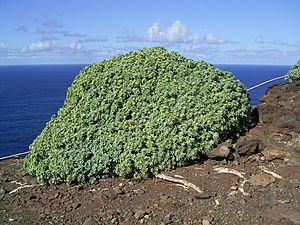Euphorbia balsamifera facts for kids
Quick facts for kids Euphorbia balsamifera |
|
|---|---|
 |
|
| Scientific classification | |
| Genus: |
Euphorbia
|
| Species: |
balsamifera
|
Euphorbia balsamifera is a cool plant often called the balsam spurge. It's a type of flowering plant that belongs to the spurge family, called Euphorbiaceae. You can find it growing in the Canary Islands and the western part of the Sahara desert. This plant is super special to the island of Lanzarote because it's their official plant symbol!
Contents
What it Looks Like
This plant can be different sizes. Sometimes it's a short bush, and other times it grows into a small tree. It can reach a height of 2 to 5 meters (about 6 to 16 feet).
Stems and Leaves
The stems of the balsam spurge can be up to 15 centimeters (about 6 inches) wide. They are a bit soft and fleshy, like a succulent plant. They don't have any sharp spines. The stems are covered with marks where old leaves used to be. Their color can be gray or a reddish-brown. The plant branches out from its base. Older parts of the plant can become thick and knobby.
The leaves are about 80 millimeters (3 inches) long and 4–8 millimeters (0.15–0.3 inches) wide. They grow in bunches at the very tips of the stems. The leaves are green and have a slightly waxy, bluish-green look. They can be long and narrow, or more oval-shaped.
Flowers and Fruit
The plant's flowers are small and grow at the end of each stem. They are usually just one tiny, yellowish-green flower-like structure called a cyathium. It's about 6 millimeters (0.2 inches) wide.
After the flowers, the plant grows a fruit. It's a large, green capsule, about 10 millimeters (0.4 inches) long and 9 millimeters (0.35 inches) wide. When it's ripe, it turns a pinkish-reddish-green color. The fruit is smooth and can sometimes be a bit hairy.
Where it Grows
Euphorbia balsamifera is originally from the Canary Islands, western Morocco, and Western Sahara.
This plant grows in dense groups, often on rocky ground or sandy areas. You can find it up to 800 meters (about 2,600 feet) above sea level. It likes plains where other succulent plants also grow. However, it doesn't grow in very shifting sand dunes.
How People Use It
Like many other Euphorbia plants, the balsam spurge has a milky sap called latex. This sap can be irritating, so it's best not to touch it or get it in your eyes.
In Morocco, people traditionally used the sap for some dental issues. They would use it for toothaches, but this was a traditional practice and not something to try at home.
Long ago in the Canary Islands, people would gather the leaves of this plant. They cooked them and ate them as a green vegetable.
Because it's a succulent plant, its trade is carefully watched. This is done under an international agreement called CITES. This helps protect the plant and make sure it's not over-collected from the wild.
See also
 In Spanish: Tabaiba dulce para niños
In Spanish: Tabaiba dulce para niños
- List of animal and plant symbols of the Canary Islands
- Euphorbia kamerunica, a related plant from Africa with similar uses

